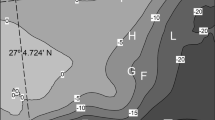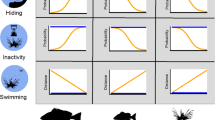Abstract
The invasive Pacific red lionfish (Pterois volitans) poses a threat to western Atlantic and Caribbean coral reef systems. Lionfish are small-bodied predators that can reduce the abundance and diversity of native fishes via predation. Additionally, native predators or competitors appear to have a negligible effect on similarly sized lionfish. Nassau grouper (Epinephelus striatus) are a regionally endangered, large predator found throughout lionfish’s invasive range. Because lionfish and Nassau grouper occupy similar habitats and use similar resources, there is potential for competition between these two species. Using large, outdoor in-ground tanks, we investigated how lionfish and Nassau grouper affect each other’s behavior by comparing their distance from and use of shelter when in isolation versus when both species were in the presence of each other with limited shelter. We found that Nassau grouper, which displayed a high affinity for shelter in isolation, avoided lionfish in two distinct ways; (1) groupers positioned closer to and used limited shelter more when paired with similarly sized lionfish and (2) grouper moved much further away from shelter when paired with smaller lionfish. We also found that neither large lionfish nor large Nassau grouper preyed upon smaller individuals of the opposite species suggesting that Nassau grouper do not recognize small lionfish as prey. This study highlights how invasive lionfish may affect native Nassau grouper, and suggests that competition for shelter between these two species may be size dependent.


Similar content being viewed by others
References
Albins MA (2013) Effects of invasive Pacific red lionfish Pterois volitans vs. a native predator on Bahamian coral-reef fish communities. Biol Invasions 15:29–43
Albins M, Hixon M (2008) Invasive Indo-Pacific lionfish Pterois volitans reduce recruitment of Atlantic coral-reef fishes. Mar Ecol: Prog Ser 367:233–238
Albins MA, Hixon MA (2011) Worst case scenario: potential long-term effects of invasive predatory lionfish (Pterois volitans) on Atlantic and Caribbean coral-reef communities. Enviro Biol Fish. doi:10.1007/s10641-011-9795-1
Barbour AB, Montgomery ML, Adamson AA, Díaz-Ferguson E, Silliman BR (2010) Mangrove use by the invasive lionfish Pterois volitans. Mar Ecol: Prog Ser 401:291–294
Beets J, Hixon MA (1994) Distribution, persistence, and growth of groupers (Pisces: Serranidae) on artificial and natural patch reefs in the Virgin Islands. B Mar Sci 55:470–483
Buchheim JR, Hixon MA (1992) Competition for shelter holes in coral-reef fish Acanthemblemaria spinosa Metzelaar. J Exp Mar Biol Ecol 164:45–52
Claydon JAB, Calosso MC, Jacob SE (2008) The red lionfish invasion of South Caicos, Turks & Caicos Islands. Proc Gulf Coast Fish Inst 61:400–402
Claydon JAB, Calosso MC, Traiger SB (2012) Progression of invasive lionfish in seagrass, mangrove and reef habitats. Mar Ecol: Prog Ser 448:119–129
Cornish A, Eklund AM (2003) Epinephelus striatus. In: IUCN 2013. IUCN Red list of threatened species. Version 2013.2. <www.iucnredlist.org>. Downloaded on 05 December 2013
Côté IM, Greene SJ, Hixon MA (2013) Predatory fish invaders: Insights from Indo-Pacific lionfish in the western Atlantic and Caribbean. Biol Conserv 164:50–61
Donahue MJ (2004) Size-dependent competition in a gregarious porcelain crab Petrolisthes cinctipes (Anomura: Porcellanidae). Mar Ecol: Prog Ser 267:219–231
Eggleston DB (1995) Recruitment in Nassau grouper Epinephelus striatus: post-settlement abundance, microhabitat features, and ontogenetic habitat shifts. Mar Ecol: Prog Ser 124:9–22
Figler MH, Cheverton HM, Blank GS (1999) Shelter competition in juvenile red swamp crayfish Procambarus clarkii: the influences of sex differences, relative size, and prior residence. Aquaculture 178:63–75
Forrester GE, Steele MA (2004) Predator, prey refuges and the spatial scaling of density-dependent prey mortality. Ecology 85:1332–1342
Green SJ, Côté IM (2009) Record densities of Indo-Pacific on Bahamian coral reefs. Coral Reefs 28:107
Green SJ, Akins JL, Maljković A, Côté IM (2012) Invasive lionfish drive Atlantic coral reef fish declines. PLoS ONE 7:3
Hackerott S, Valdivia A, Greene SJ, Côté IM, Cox CE, Akins L, Layman CA, Precht WF, Bruno JF (2013) Native predators do not influence invasion success of Pacific lionfish on Caribbean reefs. PloS ONE. doi:10.1371/journal.pone.0068259
Helfman GS (2007) Fish Conservation, A guide to understanding and restoring global aquatic biodiversity and fishery resources. Island Press, Washington DC
Hixon MA (1980) Competitive interactions between California reef fishes of the genuis Embiotoca. Ecology 61:918–931
Hixon MA (1991) Predation as a process structuring coral reef fish communities. The Ecology of Fishes on Coral Reefs. pp 475–508
Hixon MA, Beets JP (1993) Predation, prey refuges, and the structure of coral-reef fish. Ecol Monogr 63:77–101
Jud ZR, Layman CA (2012) Site fidelity and movement patterns of lionfish, Pterois spp., in a Florida estuary. J Exp Mar Biol Ecol 79:198–178
Kulbicki M, Beets J, Chabanet P, Cure K et al (2012) Distributions of Indo-Pacific lionfishes Pterois spp. in their native ranges: implications for the Atlantic invasion. Mar Ecol: Prog Ser 446:189–205
Lesser MP, Slattery M (2011) Phase shift to algal dominated communities at mesophotic depths associated with lionfish (Pterois volitans) invasion on a Bahamian coral reef. Biol Invasions 13:1855–1868
Luiz OJ, Floeter SR, Rocha LA, Ferreira CEL (2013) Perspectives for the lionfish invasion in the South Atlantic: Are Brazilian reefs protected by currents? Mar Ecol: Prog Ser 485:1–7
Maljković A, Van Leeuwen TE, Cove SN (2008) Predation on the invasive red lionfish, Pterois volitans (Pisces: Scorpaenidae), by native groupers in the Bahamas. Coral Reefs 27:501–501
Morris JA, Akins JL (2009) Feeding ecology of invasive lionfish (Pterois volitans) in the Bahamian archipelago. Enviro Biol Fishes 86:389–398
Morris JA, Whitfield PE (2009) Biology, ecology, control and management of the invasive Indo-Pacific Lionfish: An updated integrated assessment. NOAA Technical Memorandum NOS NCCOS 99
Mumby PJ, Harborne AR, Brumbaugh DR (2011) Grouper as a natural biocontrol of invasive lionfish. PloS ONE 6:1–4
Nakata K, Goshima N (2003) Competition for shelter of preferred sizes between the native crayfish species Cambaroides japonicus and the alien crayfish species Pacifastacus leniusculus in Japan in relation to prior residence, sex difference, and body size. J Crus Biol 23:897–907
O’Niell DJ, Cobb JS (1979) Some factors influencing the outcome of shelter competition in lobsters (Homarus americanus). Mar Behav Physiol 6:33–45
R Core Team (2012) R: a language and environment for statistical computing. R Foundation for Statistical Computing, Vienna, Austria, 2012 URL http://www.R-project.org. ISBN 3-900051-07-0
Ruiz G, Carlton J, Grosholz E, Hines A (1997) Global invasions of marine and estuarine habitats by non-indigenous species: mechanisms, extent, and consequences. Am Zool 632:621–632
Sadovy Y, Eklund A (1999) Synopsis of biological data on the nassau grouper, Epinephelus striatus (Bloch, 1792), and the Jewfish, E. itajara (Lichtenstein, 1822). FAO Fisheries Synopsis
Schofield PJ (2009) Geographic extent and chronology of the invasion of non-native lionfish (Pterois volitans [Linnaeus 1758] and P. miles [Bennett 1828]) in the Western North Atlantic and Caribbean Sea. Aquat Invasions 4:473–479
Schofield PJ (2010) Update on geographic spread of invasive lionfishes (Pterois volitans [Linnaeus, 1758] and P. miles [Bennett, 1828]) in the Western North Atlantic Ocean, Caribbean Sea and Gulf of Mexico. Aquat Invasions 5:S117–S122
Schultz ET (1986) Pterois volitans and Pterois miles: Two valid species. Copeia 1986:686–690
Sebens KP (1982) Competition for space: growth rate, reproductive output, and escape in size. Am Nat 120:189–197
Shulman MJ (1985) Coral reef fish assemblages: intra- and interspecific competition for shelter sites. Env Biol Fish 13:81–92
Stallings CD (2008) Indirect effects of an exploited predator on recruitment of coral-reef fishes. Ecology 89:2090–2095
Valdez-Moreno M, Quintal-Lizama C, Gómez-Lozano R, García-Rivas MDC (2012) Monitoring an alien invasion: DNA barcoding and the identification of lionfish and their prey on coral reefs of the Mexican Caribbean. PloS One. doi:10.1371/journal.pone.0036636
Van Kessel N, Dorenbosch M, De Boer MRM, Leuven RSEW, Van Der Velde G (2011) Competition for shelter between four invasive gobiids and two native benthic fish species. Curr Zool 57:844–851
Vorburger C, Ribi G (1999) Aggression and competition for shelter between a native and an introduced crayfish in Europe. Freshw Biol 42:111–119
Whitfield PE, Hare JA, David AW, Harter SL, Munoz RC, Addison CM (2007) Abundance estimates of the Indo-Pacific lionfish Pterois volitans/miles complex in the Western North Atlantic. Biol Invasions 9:53–64
Wootton JT (1994) Size-dependent competition: effects on the dynamics Vs. The end point of mussel bed succession. Ecology 74:195–206
Acknowledgments
We thank the staff and interns of the Perry Institute for Marine Science at Lee Stocking Island, Bahamas for their help and logistical support. We thank S. Hixon and K. Ingemen for their expert cage building skills and assistance in setting-up the experiment, collecting data, and enduring hundreds of mosquito bites. We also thank M.A. Hixon, M. Errend, and A. Lowe for their constructive comments in the preparation of this manuscript. All fish handling procedures were approved by IACUC though Oregon State University. This study was funded by NSF research grants 08–51162 and 12–33027 awarded to M.A. Hixon, an NSF Graduate Research Fellowship awarded to M. Albins and an Oregon State University Undergraduate Research, Innovation, Scholarship & Creativity (URISC) grant awarded to W. Raymond.
Author information
Authors and Affiliations
Corresponding author
Rights and permissions
About this article
Cite this article
Raymond, W.W., Albins, M.A. & Pusack, T.J. Competitive interactions for shelter between invasive Pacific red lionfish and native Nassau grouper. Environ Biol Fish 98, 57–65 (2015). https://doi.org/10.1007/s10641-014-0236-9
Received:
Accepted:
Published:
Issue Date:
DOI: https://doi.org/10.1007/s10641-014-0236-9




